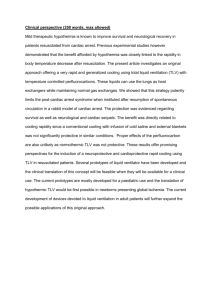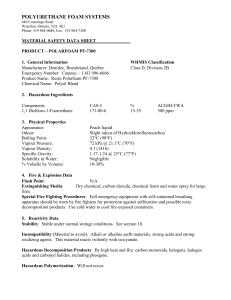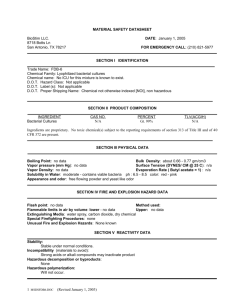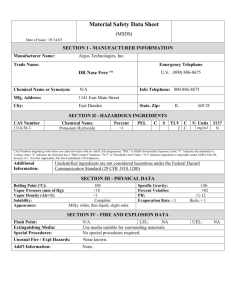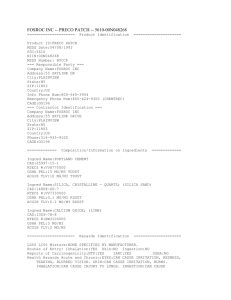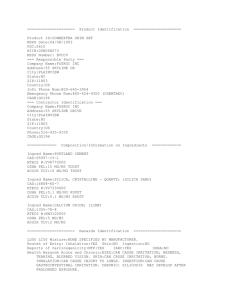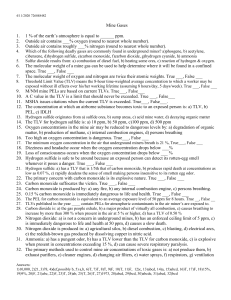CCN/NDN Protocol Wire Format and Functionality Considerations
advertisement
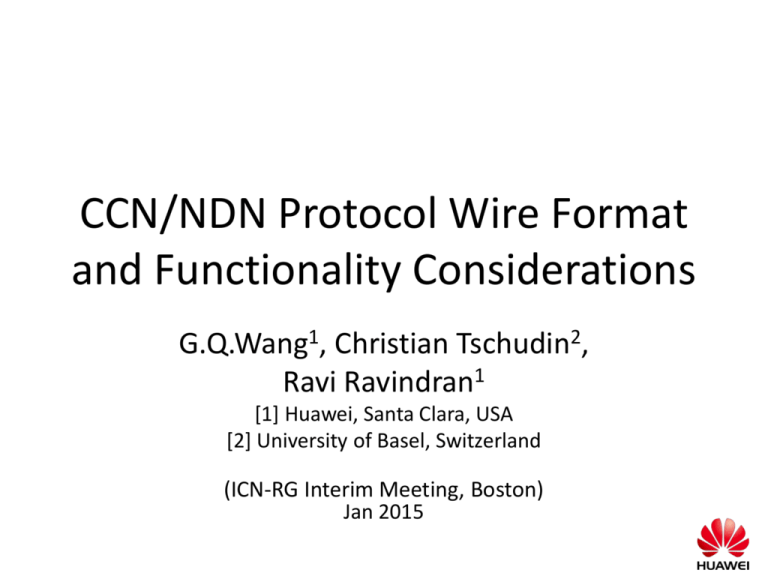
CCN/NDN Protocol Wire Format
and Functionality Considerations
G.Q.Wang1, Christian Tschudin2,
Ravi Ravindran1
[1] Huawei, Santa Clara, USA
[2] University of Basel, Switzerland
(ICN-RG Interim Meeting, Boston)
Jan 2015
Agenda
• Motivation
• Wire Packet Considerations
– Multiple TLV Schemas
– Elastic TLVs
– Forwarding Target
– Non-Shareable Content
– Context Handling
– Interest Notification
• Header Compression
• Selectors Usage
• Caching as a service
• Packet Formats
• Summary
Motivation
• TLV discussions are primarily considering
performance requirements.
• Future Internet Architecture has to accommodate
other requirements too.
– Flexibility
– Scalability
– Expressiveness
which needs support at the wire format level
• Following are some of these requirements for
future considerations.
Flexible TLV Schema(s)
• “One TLV to rule them all” is bad. Need support for a multiplicity of TLV
schemas:
– one (or few) TLV format for the fixed header
– potentially many TLV flavors in the option fields and payload
(policies might restrict what a net accepts, but the functionality is very useful)
• Examples:
–
–
–
–
To support Backward Compatibility and Service Expressiveness
forward a CCNx2.0 payload through a CCNx1.0 net
forward a NFN thunk [1] representation through CCNx1.0
Service composition/chaining [2]
• Relies on a generalized “name-to-forward-on” schema,
see the “forwarding target ptr” slide later on
• Requires sufficient Type space in Interest/Data Global Header.
• In ccn-lite v0.2.0 and its multiprotocol support, a “switch code sequence”:
[0x80, NDNENC(schemaID)] (bytes according to schemaID….)
[1]Minolakis Sifalakis, Basil Kohler et al, “An Information Centric Network
for Computing the Distribution of Computations”, ICN, Siggcomm, 2014.
[2] Peyman Talebifard, Ravi Ravindran et al “Towards a Context Adaptive ICN based Service Centric Framework”,
Qshine, Q-ICN, 2014.
Elastic TLV for CCN
Variable “Length” definition to accommodate heterogeneous
application/device/interface-capability contexts e.g. Optical, IoT
T= 2B
Flag Bits
(K=2b)
• One possibility to support large Content Payloads
L= 14 bits
(00) B/Unit-Size
(01) KB/Unit-Size
(10) MB/Unit-Size
(11) GB/Unit-Size
• The proposal keeps it simple, in terms of limiting over head to
2/2 Type and Length, while using two bits to determine
granularity of the payload.
• The selection of the per-unit resolution can be chosen by the
application, based on the feedback from ICN forwarding layer,
based on strategic path level feedback.
Identifying the Length Format to
Support Elastic Payload
• Typical format of “k+L”:
– 2k represents the number of size-level’s,
– 2k represents the matching size
• “2+14” enables 4 size-levels with 2^14 of each
component size
• How do we assign the size-level’s?
– Overlapping, as in, B, KB, MB, GB, or
– Non-overlapping, as in, B, xKB, yMB, zGB (e.g., x=16,
y=256, z=4096)
Forwarding Target (a.k.a Locator)
• Allow Interest forwarding to operate on something other than the
Interest name proper (which nevertheless stays in the packet)
• Alternate targes can be an ICN Name, or Flat Label, or …
– /huawei/g.q/phone /att/sc/ap-x [1]
– alternate name or flat label for mobility mechanisms like Kite [2]
• Supports mobility, late-binding, or other application-centric requirements.
• Proposal: store target bits as Optional TLVs (“forwarding labels”), add a
pointer (“forwarding target”). FL-flag indicates their presence
• The pointer field in the hop-by-hop hdr selects which label is the target
T={Forwarding-Target} L=sizeof(offset) V=offset-of-”FT-Bytes”
Header
[FL-Flag]
Header-len
• The Header-Len field is still used to access the Name-TLV (if FL-flag clear).
Packet layout:
Forwarding-TargetBytes
(Optional TLV)
Forwarding Label
(Optional TLV)
Interest/Data
Message TLV
Interest
Payload
[1] Aytac Azgin, Ravi Ravindran, G.Q.Wang, “Scalable Mobility-Centric Architecture for Named data
Networking”, IEEE, CCNC (SCENE Workshop), 2014
[2] Yu Zhang, Hongli Zhang, Lixia Zhang , “Kite: A Mobility Scheme for NDN”, ICN Siggcomm, 2014
Shareable versus Non-Shareable
• Non-Shareable content (e.g. conversational,
transactional) can be on fast path without
PIT/CS processing.
– As communication is bi-directional
– Include both Source/Destination Names
• As a new type of Interest/Data PDU
Global Header
(New Interest
Type)
Interest/Data
Message
<Source-Name>
<Destination-Name>
Ravi Ravindran, Asit Chakraborti, Xinwen Zhang, G.Q.Wang, “Supporting Dual Mode Forwarding in
Content Centric Networking” IEEE, ANTS, 2011
Context Handling
• Provision to include context metadata that can
be processed in the Network Layer.
– Contexts includes Identity/Location/Device etc.
– Attachment to a Service Instance
– Discovering Content/Services
– Policy based Routing/Forwarding
– Optional Interest TLVs
Global
Header
Interest/Data
Message TLV
Interest Name
<Optional Context
Metadata>
Interest Notification/Action
• Enable to Notify/Actions using Interest payload,
e.g. IoT applications
• Distinguished by a new Interest Type.
• Bypass the PIT Processing, potentially new
strategy forwarding rules (Notification Multicast)
• Name components can be label=value type.
• Could be handled in a special way by the network
– E.g. also piggyback, a cacheable object with the
Interest Notification.
• New type of Interest Packet
Fixed Header
Type=
Type = Int. Int. Not.
Not.
Interest Name
<Cacheable Object>
Sugang Li, Yanyong Zhang, Deepankar Raychaudhuri, Ravi Ravindran, “An Evaluation on ICN based IoT
Architectures” , ICN-QSHINE, 2014
Using Selectors
• Should be a Protocol Feature that can be optionally
enabled
– Implication on the PIT design
• Selectors can be avoided in the network
infrastructure with authoritative sources exist.
• Selectors are useful where authoritative source
doesn’t exist, and learning from cache or source is
the only option.
– Discovery Services, Inventory in Home, Campus etc.
– Ad hoc V2V, IoT scenarios, Pub/Sub case
Header Compression
• Hooks for header compression, especially for names.
But encoding context switching could also be used for
type dictionaries as in ccnb.
• Examples:
– Ask downstream node to accept “name abbreviations”.
The name mappings would be stored in a “context”, hence
the need for a “contextID” field in the fixed header.
– IoT setting: use a 1+1 TLV schema internally, the gateway
will expand it to 2+2 for the rest of the world.
• Remember MNP5 from modem times[1], TCP header
compression, UDP ROHC [2], and 6LoWPAN.
[1] http://en.wikipedia.org/wiki/Microcom_Networking_Protocol
[2] RFC 1144, RFC 2058, RFC 4019 (Robust Header Compression)
Caching as a Service
• CCN/NDN domains may not have any caching
at all.
• Or domains could enable caching/storage only
at the edges.
• PARC document [1] on distributing PIT/CS/FIB
functionality.
• Flexibility of handling different type of
Interest/Data PDU – Sufficient global header
Type space.
[1]http://www.ccnx.org/pubs/hhg/5.1%20CCNx%201.0%20Implications%20for%20Router%20Design.pdf
Proposed Packet Format
Interest/Data Type Space
• Motivated by different type of forwarding processing.
Interest
• Interest
• Interest-Notification
• Interest-Conversational
Data
• Data
• Data-Conversational
• CCNx1.0 Interest/Data PDU is used as a reference for the proposal.
• Definition of Payload-Len/Header Len follows CCNx1.0.
Basic TLV Design
T= 2B
Flag Bits (2b)
Elastic TLV for Content Payload
L* = 14 bits
(00) B/Unit-Size
(01) KB/Unit-Size
(10) MB/Unit-Size
(11) GB/Unit-Size
For all other TLV Except Content Object TLV
T= 2B
L = 2B
• We use the Elastic TLV structure in our proposal for
the Content Payload.
• For the rest we use the 2/2 based TLV format.
Interest PDU
Version
(1B)
Packet Type
= Interest
(1B)
Pay Load*
Length (2B)
Reserved
(2B)
Header
Length
(2B)
Fixed Header
(8B)
<Optional Forwarding Target Pointer TLV >
< Optional Forwarding Label >
< Optional headers>
Message Type = Interest
Optional
Headers
Message Length* (2B)
Name TLV
< Metadata TLV > (Selectors/Context TLV)
Security TLV
Interest
Message
MetaData
Payload
Security
Payload
• 1B Type should be sufficient to different forms of Interest Payloads.
• 2B of Payload length should be enough to accommodate all the metadata
fields related to Forwarding Target TLV, Context TLV etc.
Interest-Notification
Version
(1B)
Packet
Type =
InterestNot. (1B)
Pay Load*
Length (2B)
Reserved
(2B)
Header
Length
(2B)
Fixed Header
(8B)
< Optional headers >
< Optional Forwarding Target/Label TLV >
Message Type = Interest-Not.
Message Length* (2B)
Optional
Headers
Interest
Notification
Message
Name TLV
Metadata TLV (Context TLV)
MetaData
Payload
Security TLV
< Optional Content Object >
Optional
Content
Object
• This would be a different Interest Type.
• Optional Forwarding Target is still applicable
• Following the Interest Not. message could be a cacheable content object.
Interest-Conversational
Version
(1B)
Packet
Type =
InterestCon. (1B)
Pay Load*
Length (2B)
Reserved
(2B)
Header
Length
(2B)
Fixed Header
(8B)
< Optional headers >
< Optional Forwarding Target/Label TLV >
Message Type = Interest-Con.
Message Length* (2B)
Optional
Headers
Interest
Notification
Message
Source Name TLV
Destination Name TLV
<Metadata TLV> (Context TLV)
MetaData
Payload
Security TLV
• New Interest Type with Source and Destination
Name TLV.
DATA PDU
Version
(1B)
Packet
Type =
Data (1B)
Pay Load*
Length (6B)
Reserved
(2B)
Header
Length
(2B)
Fixed Header
(12B)
< Optional Header TLV >
Optional
Headers
Message Type = Data
Message Length (6B)
Data
Message
Name TLV
T= 2B (Content Payload)
Flag Bits
(2b)
< Metadata TLV >
L* = 14 bits
< Content >
Security TLV
•
Fixed Size payload length to accommodate Elastic Content Payload
–
•
Elastic Content
Payload
e.g. for GB should 6B : 248 > 244
The Elastic PDU allows to attach payload of varying sizes with minimum overhead.
Data-Conversational PDU
Version
(1B)
Packet
Type =
Data.Con
(1B)
Pay Load*
Length (6B)
Reserved
(2B)
Header
Length
(2B)
//Optional Data headers
<Forwarding Target>/<Forwarding Label>
Message Type = Data-Con.
Fixed Header
(12B)
Optional
Headers
Message Length (6B)
Source Name TLV
Data
Message
Destination Name TLV
T= 2B (Content Payload)
Flag Bits
(2b)
Metadata TLV
//Content
Security TLV
L* = 14 bits
Elastic Content
Payload
• New type of Data to handle conversational traffic
Summary
• CCN/NDN Protocol design not just on
performance, but also on flexibility, scalability,
and expressiveness.
• Several considerations laid out to be accounted
for current design and future enhancements.
• Eventual consensus between CCN and NDN, do
not desire two versions of the same protocol.
• Interest/Data Packet formats proposed for
consideration.
